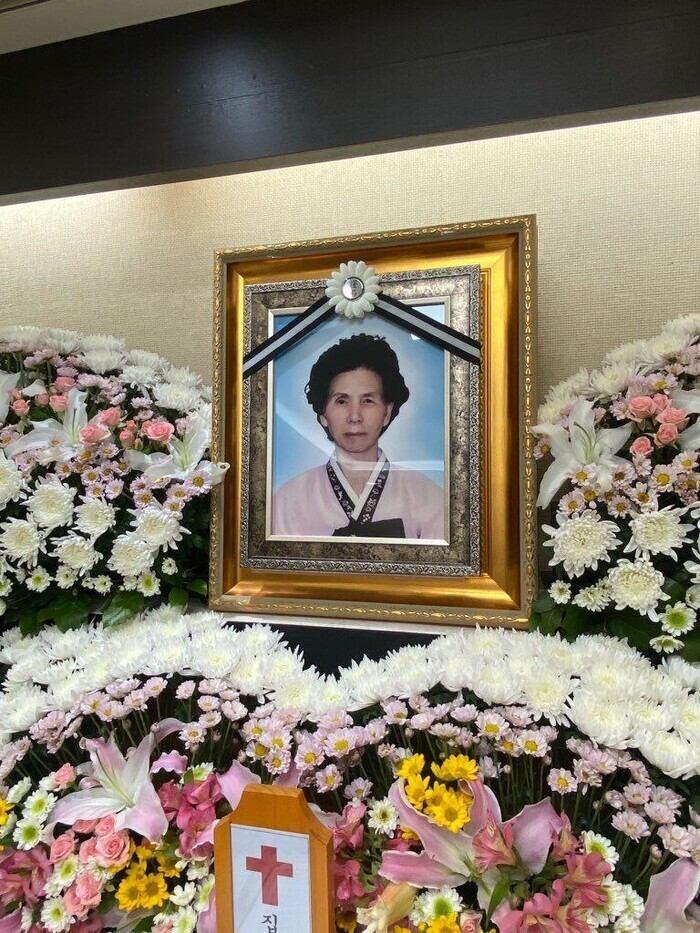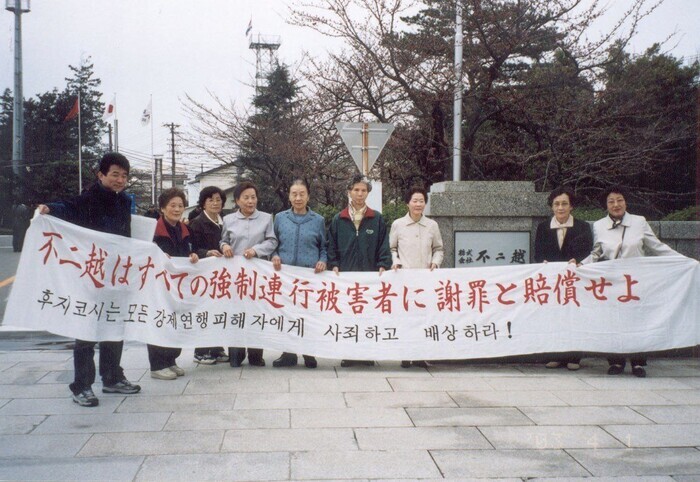hankyoreh
Links to other country sites 다른 나라 사이트 링크
Na Hwa-ja, victim of forced labor for Japan, dies before being compensated

Na Hwa-ja, who was forced to provide labor as part of the Korean Women’s Volunteer Labor Corps during Japan’s colonial rule of Korea, has died. She was 91.
The Center for Historical Truth and Justice announced Thursday that Na had died around 5 pm of a chronic condition on Wednesday. She had been hospitalized at the National Medical Center.
Born in Naju, South Jeolla Province, in October 1931, Na was drafted to provide forced labor at a Fujikoshi factory in Japan’s Toyama Prefecture in February 1945, when she was in the sixth grade.
An unfamiliar man introduced by her homeroom teacher told Na about a work opportunity at Fujikoshi. The man told Na that working in Japan would allow her to make money and afford school, giving her a way out of her life of poverty.
That explanation initially convinced Na to go to Japan, but she changed her mind because of opposition from her parents. After hearing that Na didn’t mean to go after all, her teacher threatened to send her father to Japan in her stead if she refused to go. In the end, Na didn’t tell her family about her plans until the very day she was taken to Japan.
Na went hungry at the Toyama plant and performed back-breaking labor for 12 hours every day cutting iron with a lathe.
She returned to Korea after liberation but did not receive any wages. At that time, around 1,600 Koreans were taken to Fujikoshi and mobilized for forced labor. Fujikoshi Steel Industry, which was a military supply company during World War II, was one of the main companies that mobilized Koreans for forced labor.

Na had previously filed a lawsuit for compensation of damages in 2003 against Fujikoshi at the Toyama District Court in Japan but her claim was dismissed. She then filed another lawsuit in 2013 in a domestic court which was followed by a ruling of the Seoul High Court in January 2019 calling for the offending company, Fujikoshi, to compensate the plaintiffs.
Since then, it has been a continued wait to hear the final ruling from the Supreme Court, which has already taken four years. Na’s bereaved family plans to see the unfinished lawsuit through to the end.
Currently, 14 of the 23 plaintiffs in the lawsuit against Fujikoshi (now Nachi-Fujikoshi) have already passed away and nine survivors are awaiting the Supreme Court’s final ruling on the case.
Na’s wake was prepared at the funeral hall of the National Medical Center in central Seoul. The funeral procession is set to take place on Saturday and the burial site will be at the Sian Family Memorial Park in Gyeonggi Province.
By Yoon Yeon-jeong, staff reporter
Please direct questions or comments to [english@hani.co.kr]

Editorial・opinion
![[Column] Season 2 of special prosecutor probe may be coming to Korea soon [Column] Season 2 of special prosecutor probe may be coming to Korea soon](https://flexible.img.hani.co.kr/flexible/normal/500/300/imgdb/original/2024/0426/3317141030699447.jpg) [Column] Season 2 of special prosecutor probe may be coming to Korea soon
[Column] Season 2 of special prosecutor probe may be coming to Korea soon![[Column] Park Geun-hye déjà vu in Yoon Suk-yeol [Column] Park Geun-hye déjà vu in Yoon Suk-yeol](https://flexible.img.hani.co.kr/flexible/normal/500/300/imgdb/original/2024/0424/651713945113788.jpg) [Column] Park Geun-hye déjà vu in Yoon Suk-yeol
[Column] Park Geun-hye déjà vu in Yoon Suk-yeol- [Editorial] New weight of N. Korea’s nuclear threats makes dialogue all the more urgent
- [Guest essay] The real reason Korea’s new right wants to dub Rhee a founding father
- [Column] ‘Choson’: Is it time we start referring to N. Korea in its own terms?
- [Editorial] Japan’s rewriting of history with Korea has gone too far
- [Column] The president’s questionable capacity for dialogue
- [Column] Are chaebol firms just pizza pies for families to divvy up as they please?
- [Column] Has Korea, too, crossed the Rubicon on China?
- [Correspondent’s column] In Japan’s alliance with US, echoes of its past alliances with UK
Most viewed articles
- 1‘We must say no’: Seoul defense chief on Korean, USFK involvement in hypothetical Taiwan crisis
- 2After election rout, Yoon’s left with 3 choices for dealing with the opposition
- 3Why Kim Jong-un is scrapping the term ‘Day of the Sun’ and toning down fanfare for predecessors
- 4Noting shared ‘values,’ Korea hints at passport-free travel with Japan
- 5AI is catching up with humans at a ‘shocking’ rate
- 6[Editorial] Korea’s surprise Q1 growth requires objective assessment, not blind fanfare
- 7Two factors that’ll decide if Korea’s economy keeps on its upward trend
- 8Yoon says collective action by doctors ‘shakes foundations of liberty and rule of law’
- 9Amnesty notes ‘erosion’ of freedom of expression in Korea in annual human rights report
- 10South Korea a veritable tax break paradise for chaebol